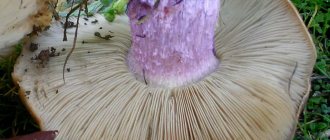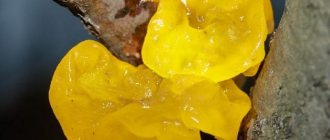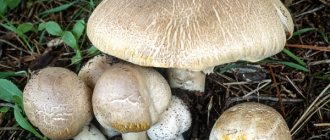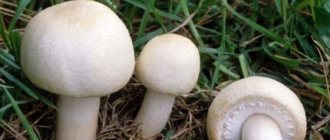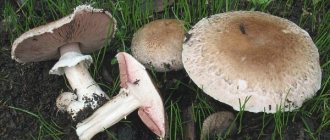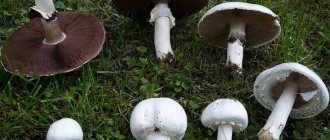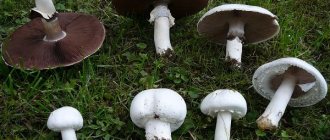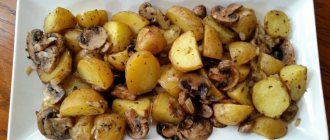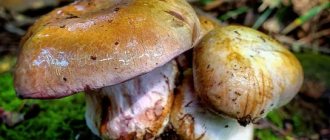Characteristics and description of edible mushroom
Forest champignon is a mushroom of the Champignon family, genus Champignon. Its popular names are: kolpak, blyushka, wolf mushroom. Latin names: Agaricus sylvaticus, Psalliota silvatica, Pratella silvatica, Fungus silvaticus.
Its cap is 7–10 cm in diameter (sometimes up to 15 cm), shaped like an egg, over time it becomes flat-spread, saucer-shaped, and often has a protruding tubercle. Fibrous, especially in the center, dotted with dark scales. Its color is pinkish-rusty-brown, sometimes with a purple tint.
The hymenophore (back side of the cap) is lamellar. It is white with a pink tint. With age it darkens and acquires a dirty red color. In a ripe mushroom, the plates become brown, even violet-brown, almost black.
The flesh is white when cut, then turns red. Doesn't release juice. Has a faint pleasant odor.
The leg is often long and thin, from 4 to 10 cm, 1–2 cm wide, cylindrical in shape, slightly thickened at the base. Light color, white-grayish. At the top it has a sagging membranous ring that disappears with age. The stem is easily separated from the cap and turns red at the break. Reference! Larger representatives of the species are found in coniferous forests in autumn.
Description
The name of these mushrooms has French roots.
In translation it sounds like “mushroom”. What does champignon look like? It is impossible to give a more or less unambiguous answer to this question, since this species of representatives of the fungal kingdom has a huge number of varieties. However, there are some distinctive features that are, to one degree or another, characteristic of all owners of this French name. If you ask the question seriously and study the large number of existing photos on the topic “What do champignons look like?”, you will notice that the stem of these mushrooms is usually white, 3-10 centimeters long, although there are also taller specimens. Usually the leg has a cylindrical shape, in some cases, with an extension towards the bottom. This part of the mushroom is either solid or hollow inside. If the leg is broken, then at the place of the break white flesh will be visible, which sometimes, when pressed on it, acquires a different color, depending on the specific type of champignon (most often the color is yellow, reddish or brownish).
It is necessary to remember that all mushrooms of this species have a “skirt” on the stem, or a ring-shaped trace from it. Sometimes there are champignons with two rings. By this identification mark, you can distinguish the edible champignon from its inedible relatives, or from its “doubles,” which may be toadstools and some varieties of fly agarics.
A little history
Today it is difficult to determine the country of origin of champignons. Italy and France are vying for the lead in this. Only the origin of the fruit’s name is known for certain: it goes back to the French “champignon” and means “mushroom”. Subsequently, the species spread to many countries and became popular in England, Hungary, the USA, etc.
Its cultivation began in the fifth republic in the century, when mushrooms migrated from the meadows to special underground premises. In the castles of the rulers of many European countries, places were equipped for the artificial cultivation of champignons. They were considered a delicacy, a rare and valuable delicacy.
In 1762, the species was described by the German mycologist Jacob Christian Schaeffer. The researcher gave it the name Agaricus sylvaticus.
Preparing the substrate for champignons
The technology for growing champignons is based not only on coolness, dampness and ventilation, but also on fertile soil. It is not for nothing that in nature, mushrooms of the family appear on black soil, near farms and other areas flavored with manure.
We conclude: champignons love organic fertilizers. There should also be trace elements that go into the mushrooms, such as potassium and phosphorus.
Manure becomes the basis of the substrate. That is, we prepare compost. The chemical processes occurring in it are complex. It is impossible to calculate the percentage of certain elements of the mixture after it has rotted.
So, in the matter of forming a substrate for champignons, the so-called instinct and, of course, experience are important. But, there are several nuances that bring you closer to success. So, horse manure is preferable. Cow and chicken droppings are taken when it is not possible to get horse excrement.
The second component of compost is straw. Rye or wheat is preferred here. For 100 kilos you will need at least 75 manure, that is, its ratio to straw is approximately 1 to 1. Keep in mind that it is better to take a little more straw. If it is less than a hundredweight, fermentation processes will not start in the compost.
The compost is placed in inorganic containers, preferably concrete, to rot. Contact with soil, wood, and rainwater is prohibited. From them, spores of pest fungi and parasite eggs can pass into the substrate.
First, straw is placed in the compost container, pouring boiled water over it. So the mass decomposes from 3 to 5 days. At least 350 liters of water will be used. The straw will begin to “burn.”
At this point, manure is added, mixed and piled into a pile. This is the name given to trenches in heaps of sedum vegetables. But, you can use special containers, or pits lined with polyethylene.
For 100 kilos of straw and the same amount of manure, an area of 1.5 by 2 meters will be required. You will get about 2 quintals of the finished substrate. It is enough for 3 square meters of usable area for growing mushrooms.
Compost for growing champignons, as already mentioned, can be laid out in bags, shelves, and wooden boxes. In the latter case, it is necessary to treat the containers against mold fungi.
The situation is different with so-called blocks. They are gaining popularity due to their unpretentiousness and budget. Let's get acquainted with the method.
Time and place of fruiting
The forest champignon mushroom grows in July - October, most actively from August, in the autumn. In warm weather, fruiting in the fall can continue for quite a long time, until the end of November. It is found everywhere: in forests, fields and meadows, near human habitation.
Prefers mixed and coniferous forests, places with young spruce plantings. Often settles near ant heaps or directly on them. It grows singly or in groups, sometimes in “witch rings.”
This is a saprophytic species, so it loves manure, humus, soils saturated with organic matter and nitrogen.
Caps live in European countries and Asia. On the territory of Russia they are more often found in temperate zones. They can appear cyclically in the same place every 2-3 weeks, and experienced mushroom pickers are aware of this pattern by returning to the same areas.
Video
Varieties of champignons
There are several classifications:
- Based on the presence of rings: two-ring and single-ring champignons are distinguished;
- By habitat:
- Forest soil saprophytes: forest champignon, sh. coppice.
- Soil saprophytes of open spaces devoid of plant cover: bisporus champignon, sh. double-ring, or sh. sidewalk, sh. half-shod.
- Herbophiles (only among grass): common champignon, sh. August.
- Growing in open spaces among grass and in forests: field champignon, sh. elegant.
- Desert (including halophiles): Bernard champignon.
Each type of champignon has slight external differences and a special taste. There are also differences in the structure and color of the pulp.
All of the above varieties are edible. But inedible and poisonous champignons are found in nature, which a mushroom picker must be able to distinguish from edible ones. There are also double mushrooms or false champignons, which are similar in description to ordinary champignons. If you look closely, it is easy to find characteristic differences.
How to distinguish forest champignon from false doubles?
The sweet champignon has a poisonous counterpart - the variegated or dark-scaly champignon. Their similarity is great, but not critical: it is not difficult to distinguish the inedible twin by the color of the pulp, which turns yellow when broken, as well as by its unpleasant odor.
Another mushroom that can be confused with wild champignon is toadstool. They differ in the color of the plates: the champignon has pinkish or dirty purple membranes, while the insidious imitator has white membranes.
The toadstool does not change color when cut, the cap turns red. The leg of the champignon is straight, while the toadstool has a pouch at the base.
You can see the characteristics of dangerous rivals and how they may look different, as well as familiarize yourself with similar signs in the photo. The differences between the types are indicated in the table.
| Names of mushrooms | Pulp on the break | Plates | Leg |
| Forest champignon | Blushes | Pinkish, dirty red | Rovnaya |
| Variegated champignon | Turns yellow and produces an unpleasant odor | Base of the leg swollen, with yellowing pulp | |
| Death cap | Does not change color | White | At the base thickening with a bag |
Difference from other species
Inexperienced mushroom pickers are advised to go on a quiet hunt with a more experienced companion, because there are many dangerous doubles that look very similar to champignons.
False, inedible champignons
Most often, inedible species live in forested areas, but can be found in gardens, parks and meadows. Externally, the inedible fruits are very similar to champignons, but have distinctive features. When pressing on the fruiting body, the twins immediately become yellow, and the cut site at the base becomes bright yellow, which gradually turns orange or brown. Edible ones smell pleasantly of anise, and their counterparts have a “pharmacy” smell of iodine or carbolic acid.
The following species pose a great danger to human health:
- reddish (A. xanthoderma);
- yellow-skinned (A. xanthodermus);
- flat-capped (A. placomyces).
The most accurate way to determine the unsuitability of a mushroom is heat treatment. Mushrooms placed in boiling water turn bright yellow along with the water for a few seconds. When boiling, the unpleasant smell of medicine intensifies, but only for a couple of seconds. These fruiting bodies should not be eaten, because toxic substances do not disappear after boiling.
You may be interested in:
What is the name of a mushroom with a red cap and its description (24 photos) Very often, mushroom pickers encounter many different mushrooms with a red cap in the forest. They usually look very...Read more...
Mushrooms similar to champignons with white plates
In addition to close relatives, the mushroom can also be confused with other similar mushrooms. Young edible fruits are very similar to the pale toadstool and light-colored types of fly agarics.
Spring fly agaric
These poisonous species with white plates live in coniferous and mixed forests, so they can be mistaken for coppice champignon. Its appearance is practically no different from poisonous mushrooms: there are scales on the surface of the cap, the shape of the caps is the same, the white color of the plates and the presence of a ring on the stem.
Death cap
As you know, with age, champignons change the color of the plates, while the plates of toadstools and fly agarics remain snow-white all the time. When pressed, the poisonous fruit does not turn yellow, and its stem always grows from the volva, which is not always clearly visible.
Evaluation of taste qualities, medicinal properties, benefits and possible harm
Champignon is a generally recognized edible mushroom, although it is classified in the third category of nutritional value. Many consider it a delicacy. The fruit is universal, you can create a wide variety of dishes from it: boil, fry, marinate, stew, dry, even eat fresh.
The tastiest and healthiest are young specimens with gray-red plates. However, this same type of membrane sometimes scares off inexperienced mushroom pickers.
Champignons are widely used in medicine and cosmetology. They are used for tuberculosis, jaundice, ulcers and eczema, diabetes, bronchitis, headaches, and a drug is made for the treatment of typhus.
An oil extract from them successfully fights skin problems. Some beauty salons offer clients lotions, masks and other beauty products that contain this mushroom. And the price of such balms is quite high.
Eating champignons does not cause any fundamental harm. It can only be associated with environmental factors (since the fruits absorb harmful substances from the soil and air), as well as with the property common to all mushrooms that it is difficult for the body to digest.
Therefore, it is preferable to collect them in clean places and wash them before cooking. Do not abuse the product while eating, especially for people with liver diseases and children.
Useful properties of pecheritsa
Pecheritsa are rich in protein, so they can be a meat substitute for vegetarians or during fasting. In addition to protein, they contain amino acids necessary for the normal functioning of the body, minerals and carbohydrates. Pecheritsa are also popular among nutritionists. Their KBZHU indicators (calorie content, the ratio of proteins, fats and carbohydrates) are as follows: calorie content is only 270 kcal per kg of product, and the glycemic index is 15 units. With such a low calorie content, pecherits have a high energy value. Few foods on the calorie table are so low or have such significant energy value.
Pecheritsa are also record holders for the content of B vitamins. Medicine knows that they contain antioxidant properties and folic acid, which is necessary for women’s health. Pecheritsa are also rich in fiber and are useful for high cholesterol levels.
There is currently ongoing debate about the benefits of eating raw pecheritsa. Of course, a fresh product contains much more useful substances than one that has been heat-treated. But the organism, which was grown with insecticides, can easily be poisoned. It is better to heat-treat purchased products. The taste of heat-treated pecheritsa is much better.
When cooking mushrooms, cut them rather than cook them whole, this will help determine whether the organism is edible. And only then it can be boiled, fried or stewed. Poached mushrooms are delicious, i.e. fried over low heat in butter for 5-7 minutes. Cooking and stewing do not exceed 15 minutes.
Contraindications to the use of champignons
It is not advisable to eat mushrooms if you have a stomach ulcer.
If you have pancreatitis, gout and gastritis, you should refrain from eating pecheritsa. Mushrooms are also not recommended for stomach ulcers. If these diseases are not in the acute stage, then eating mushrooms in small quantities will not cause harm to the body. You should give preference to dishes that are cooked not in vegetable oil, but in water.
Any mushroom is an allergen, so it is recommended to consume them in moderate doses. And allergy sufferers should first find out whether they have an intolerance to the components of mushrooms. Pecheritsa are also contraindicated during lactation.
Their use is not contraindicated for diabetics either.
It does not matter what type of diabetes we are talking about. Pecheritsa are also used for cancer
If we talk about age restrictions, then mushrooms are not recommended for young children. It is better to introduce pecheritsa into the diet of children at the age of 4-6 years. This is due to the fact that chitin in mushrooms is poorly absorbed by the child’s body.
Video gallery
Video reviews
A selection of videos with descriptions and recipes for preparing mushrooms
HEALTH and BEAUTY FROM CARROTS, Visiting Rupych, Smart Animals / Smart Animals
Technology for growing champignons in the garden
Those who want to grow mushrooms in an open area need to know some nuances, since champignons are quite whimsical. They do not like bright light, so any shaded area is a suitable place to build beds. To protect the soil from drying out, you should make a canopy.
The first step is to prepare the compost. To do this, lay layers of straw, manure and litter. Water every day, avoiding drying out. After 3 weeks the compost will be ready.
It is necessary to sow mycelium (a kind of mushroom seeds that can be purchased in the store) onto the loosened soil, cover with a 5-centimeter layer of compost and water. Fruiting occurs after 2.5 months.
For those who plan to grow mushrooms all year round, it is important to know that champignons do not need lighting, so for the winter they can be moved to any damp and warm room with an air temperature of at least +15 degrees
Interesting Facts
- Champignons became the first variety of mushrooms to produce crops in an artificial environment.
- They are so popular that they are used even where they are not very revered. The USA is the leader in the production of champignons. France is in second place. The third position is occupied by Great Britain, where these fruits began to be consumed relatively recently. They are loved by the Poles, who add them to almost all national dishes.
- This noble dietary product, with its high nutritional properties, promotes weight loss due to its low calorie content.
It is difficult to overestimate the taste of Champignon mushrooms, and the benefits from them are significant. Try adding some of these mushrooms to a sandwich you take to work or to a simple homemade soup. You will feel that your body is very grateful to you for this delicacy.
Information sources
- Agaricus silvaticus // CBS-KNAW Fungal Biodiversity Center Utrecht, 2016
- Schaeffer, J.C. 1774. Fungorum qui in Bavaria et Palatinatu circa Ratisbonam nascuntur Icones
- Gribi Khmelnytchini. Chief assistant. Govorun V. D., Tymoshchuk O. O. - Khmelnitsky: Polygraphist-1, 2014
Possible harm to the body
The plant should also be used with caution if a woman is pregnant. Elderly, weakened people, nursing mothers and young children (under 6 years of age) should avoid such food.
Any collector must remember an important rule - it is strictly forbidden to “hunt” any mushrooms in unfavorable areas, for example, near factories or industrial buildings, along highways, close to cities/landfills. Even edible forest products can become poisonous when saturated with toxins from the environment.
Nutritional value and chemical composition
The energy value of forest champignons is 27 kcal/100 g of product. The composition includes the usual set of vitamins for mushrooms, micro- and macroelements, vitamins, fats, proteins, carbohydrates, and dietary fiber.
The composition of the blagusha mushroom includes (100 grams of product):
- thiamine – 1 mg;
- riboflavin – 0.4 mg;
- ascorbic acid – 2 mg;
- nicotinic acid – 0.5 mg;
- folic acid – 0.016 mg, and more.
Signs of poisoning and first aid
If you have not learned to recognize the edible ones among all types of champignons and accidentally collected toadstools, then after consuming them you will experience symptoms of poisoning.
Find out what the symptoms of champignon poisoning are.
They may differ from person to person, but in general the picture will look like this:
- 2-3 hours after eating mushrooms, vomiting and upset are observed;
- gastric colic and cramps will then appear;
- the temperature will rise;
- diarrhea will begin.
Afterwards the condition improves for 1-2 days. At this time, toxins actively attack the liver and kidneys, which after a couple of days affects their performance. As soon as the first symptoms of poisoning appear, you should urgently call an ambulance. While the doctors are traveling, it is necessary to cleanse the body. You should drink a liter of a weak solution of potassium permanganate to induce vomiting. Then drink sorbents - 1 g/1 kg.
Place a warm heating pad on your stomach and legs to prevent blood circulation from being disrupted. Drink strong tea or warm water. False champignons are treacherous plants. They skillfully disguise themselves as edible mushrooms, thereby attracting attention. But this feature is fraught with serious consequences for inexperienced lovers of “silent hunting”. Therefore, if you do not understand mushrooms, but want to enjoy champignons, go to the store for them.
Application
In cooking
A variety of recipes recommend preparing dishes from recently collected, completely fresh mushrooms. The same things are prepared from forest champignons as from other mushrooms. These mushrooms are not prepared for the winter due to the lack of bright taste and aroma. The mushroom is most delicious in first courses and sauces.
Harm and contraindications
It is not recommended for use in nutrition by people with digestive problems or stomach diseases.
Forest champignons contain fungin, which is difficult for humans to digest, so mushrooms are not given to preschool children (preferably under 5 years old, ideally up to 7 years old) and to women during pregnancy and to people with allergies.
Benefits of mushroom
Fresh champignon is considered a low-calorie product , 100 g contains only 27 kcal, it contains water-soluble protein albumin and a huge amount of useful microelements, so it can easily be included in weight loss diets. Fans of a healthy lifestyle, vegetarianism, as well as those suffering from anemia or diabetes simply cannot do without it.
100 g of these mushrooms contain: proteins - 4.3 g; fats - 1.0 g; carbohydrates - 0.1 g; ash - 1.0 g; water - 91 g.
- The high content of phosphorus, iron, amino acids, biotin and other active substances in it will allow:
- remove toxins;
- improve the metabolic process in the body;
- tone up your well-being;
- relieve fatigue;
- calm the nervous system;
- ensure the prevention of heart attacks and strokes;
- restore gastric and intestinal processes;
- reduce appetite;
- strengthen muscle mass;
- lower cholesterol levels;
- improve memory and concentration;
- strengthen connective tissues, teeth, bones, skin, hair, nails.
Important! The increased content of chitin in champignons has contraindications for the child’s body.
Chitin is poorly absorbed in adults and is not absorbed at all in children, so they have no place in the children's diet.
Growing
The mushroom was cultivated in the 17th century thanks to a lucky coincidence of unfortunate circumstances. One of the French peasants, who was hiding from war and loans in the tangled catacombs of Paris, discovered that the path was blocked by piles of horse manure. Over the years it was dumped into a sort of sewer. Snow-white champignons stood out brightly against the dark, fetid background.
An enterprising man soon built up all the passages under the squares of the capital with mushroom farms . His friend helped him cope with the bountiful harvest and ensured the supply of champignons to all markets. The loans were closed, the profitable business brought in income. And now hundreds of peasants have taken up this business.
They say that Napoleon banned the further development of the mushroom business in Paris, so that due to the numerous underground farms the city would not go underground. Only the construction of the metro could finally stop the champignon business in Paris: from that time until now, the main production has been located in the Loire.
Did you know? One of the large Russian retail chains has established a full cycle of its own production of champignons on a site measuring more than 50 hectares. Such a plant produces about 6,500 tons of mushrooms per year.
Mushroom growing is a simple and exciting hobby that is profitable . Many have gotten the hang of growing edible champignons on their own in their plots, especially since the market offers the opportunity to buy already sown blocks. The technology is simple; it is important to observe proper growing conditions.
1 - moistening and mixing the substrate; 2 - mixing the pasteurized substrate with mycelium; 3 - making cuts on a bag filled with seeded substrate; 4 - placement of blocks for growing mushrooms on racks with vertical hanging.
If the following conditions are stable throughout the year, no difficulties are expected:
- constant room temperature fluctuates slightly, from +22 to +25°C;
- humidity does not fall below 85–95%;
- modified gas environment designed to comply with storage conditions and mandatory ventilation for the growth of fungal bodies;
- shading to avoid direct sun.
When the rudiments of the mushroom body hatch, it is necessary to gradually, over five days, reduce the air temperature to +14...+16°C. Without ventilation, growth will stop. Therefore, air flows must necessarily enter the room.
Important! Champignons grown at home are not cut with a knife as usual, but twisted out of the ground!
Moderate watering when the first mushrooms appear should not exceed 1.5 liters of water per 1 m² of planting. The harvest is harvested in waves over 3-4 months with a one-week pause when the maximum size of the fruiting body is reached.
The integrity of the film under the champignon cap should not be compromised during their collection and storage.
Champignons dominate Russian mushroom production, but the market is still far from being completely saturated. The United States is the leader in production, France is in second place in cultivation, and England is in third place, where, in general, mushrooms are treated with great distrust.
Little Poland produces more than 200,000 tons per year, the even smaller Netherlands produces over 300,000 tons, while China leads the world with 5 million tons per year.
Find out what equipment is required to grow champignons.
Where, when and how does it grow
In the wild, forest champignons (photos and descriptions of mushrooms are given in the corresponding chapters) grow in deciduous, mixed, and coniferous tracts of the temperate climate zone, in the northern conditions on the continents of Eurasia, South and North America, and grapes grow in England.
The mushroom is also found in park areas of cities, on forest edges, and often chooses places to grow near anthills. Fruiting begins in June-July and continues until cold weather. You can find single and group growth sites. Sometimes fruit trees grow in circles.
